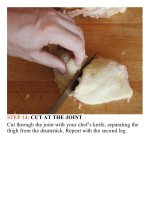The food lab better home cooking through science ( PDFDrive ) 474
Bạn đang xem bản rút gọn của tài liệu. Xem và tải ngay bản đầy đủ của tài liệu tại đây (177.42 KB, 2 trang )
moisture as you cut it. It practically oozes juices as you
chew. Equally stunning results can be achieved with pork,
whichwillsubmittoyourforklikebutter.
With some foods, the final serving temperature you’re
afterisactuallybelowthelevelatwhichbacteriabegintobe
actively killed off. Rare salmon, or steak, is around 120°F,
forexample.Forfoodslikethese,youmustbeverycareful
nottoletthemsitfortoolong.Tobesafe,Idon’tholdmy
medium-raresteaksorsalmoninthecooleranylongerthan
3 hours. After that, dinner becomes a game of Russian
roulette.Andnever,evercookfoodinthecooler,letitcool,
andreheatit.Thisisabsolutelyinvitingillnessorworse.
Withthatsomewhatdrylessonoutoftheway,let’smove
ontotheactualtechniques—thefunpart.
COOKINGINYOURCOOLER
These recipes require an accurate thermometer as well as a
beer cooler with at least a 2.5-gallon capacity and a tightfitting lid. Some coolers retain heat better than others. Heat
retentioncanbefurtherimprovedbydrapingseveraltowels
over the cooler during cooking. Leaving it in a warm spot
alsohelps—Ileavemineindirectsunlightonawarmdayor
inawarmcornerofthekitchenindoors.Herearethebasic
stepsforcookinginyourcooler:
1. Season the food generously on all sides with salt and
pepper. Place in a single layer in gallon-sized zipperlock freezer bags along with any aromatics or rub.
Squeezeoutasmuchairfromthebagsaspossiblewith
your hands and close them, leaving 1 inch unsealed.
(Seephotoshere.)
2. Heat at least 2 gallons of water to the designated
temperature, using an instant-read thermometer to
ensure accuracy (the hot water from your tap may be
hotenough,withouthavingtoheatitonthestovetop).
Pourthewaterintothecooler.
3. One at a time, slowly submerge each bag of food in
thewateruntilonlytheunsealededgeisexposed.Any
remaining air should have been forced out of the bag
asitwassubmerged.Sealthebagcompletely.
4.Closethecooler,drapeitwithafewtowels,andsetit
in a warm spot for the specified cooking time,
checking the temperature of the water every 30
minutes or so and topping it up with boiling water as
necessarytomaintainitatwithin3or4degreesofthe
desiredfinaltemperature(withaverygoodcooler,this
maybeunnecessary).
5.Removethefoodfromthebagsandsearinhotfat,on
a grill, or with a blowtorch to trigger the Maillard
reactionandaddtexturalcontrasttothefood.
SEARING
A
s I mentioned earlier, sous-vide cooking is
deficient in one key aspect: it doesn’t brown your
meat. The browning reactions that give your meat









